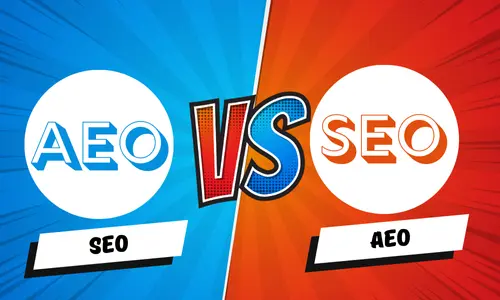In the ever-evolving world of digital marketing, two terms frequently come up: SEO and AEO. While they might sound similar, they serve distinct purposes in helping businesses thrive online. SEO, or Search Engine Optimization, has long been the cornerstone of driving organic traffic to websites. On the other hand, AEO, or Answer Engine Optimization, is an emerging concept tailored to the rise of voice search and AI-driven queries. If you’re wondering how these strategies differ and which one suits your needs, this blog will break it down for you.
Understanding SEO: The Foundation of Online Visibility
SEO is all about optimizing your website to rank higher on search engine results pages (SERPs) like Google, Bing, or Yahoo. It involves a mix of techniques such as keyword research, on-page optimization, link building, and technical fixes to make your site more appealing to search engines. The goal? To attract users searching for specific terms and convert them into customers.
For example, a business might use SEO and AEO tactics to ensure their site appears when someone types “best coffee shops near me.” SEO focuses heavily on written content, meta tags, and backlinks to establish authority and relevance.
What is AEO? The New Kid on the Block
AEO, or Answer Engine Optimization, takes a different approach. Instead of targeting broad search engine rankings, it optimizes content to provide direct, concise answers to user questions—especially those asked via voice assistants like Siri, Alexa, or Google Assistant. With the rise of AI and natural language processing, SEO and AEO are increasingly intertwined, yet AEO prioritizes conversational queries.
Imagine asking, “What’s the fastest way to brew coffee?” AEO ensures your content is structured to deliver a quick, accurate response that voice search devices can easily pick up. It’s less about ranking for keywords and more about being the go-to answer source.
Key Differences Between SEO and AEO
While SEO and AEO both aim to boost online presence, their methods and focus areas differ significantly. Let’s explore the main distinctions:
1. Purpose and Focus
SEO targets visibility on search engines through rankings, driving traffic over time. AEO, however, focuses on delivering immediate answers, often for voice or AI-driven searches.
2. Content Style
SEO thrives on detailed blog posts, keyword-rich pages, and comprehensive guides. AEO leans toward short, precise, question-and-answer formats that cater to conversational searches.
3. User Intent
With SEO, the intent might range from research to purchase. AEO zeroes in on informational intent—users seeking quick solutions or facts.
4. Technology
SEO optimizes for traditional search engines, while AEO aligns with AI tools, chatbots, and voice assistants shaping the future of search.
Why SEO and AEO Matter Together
Here’s the catch: SEO and AEO aren’t rivals—they’re complementary. A smart digital strategy combines both to maximize reach. For instance, a well-optimized blog post (SEO) can rank high on Google, while a FAQ section within it (AEO) answers specific voice search queries like “How does SEO work?”
Businesses ignoring AEO risk falling behind as voice search grows—over 50% of searches are predicted to be voice-based by 2030. Meanwhile, neglecting SEO means missing out on the vast audience still typing queries into search bars.
How to Optimize for SEO and AEO
For SEO:
- Research high-volume keywords relevant to your niche.
- Create long-form, engaging content with proper headings and links.
- Improve site speed and mobile-friendliness.
For AEO:
- Use question-based headings (e.g., “What is AEO?”).
- Provide clear, concise answers in your content.
- Structure data with schema markup to help AI understand your site.
By blending SEO and AEO, you cater to both human readers and smart devices, future-proofing your online strategy.
Final Thoughts: SEO vs. AEO—Which Wins?
There’s no winner in the SEO and AEO debate because they serve different yet overlapping purposes. SEO builds a strong foundation for long-term traffic, while AEO positions you as the instant answer authority in a fast-paced, voice-driven world. The real victory lies in mastering both.
